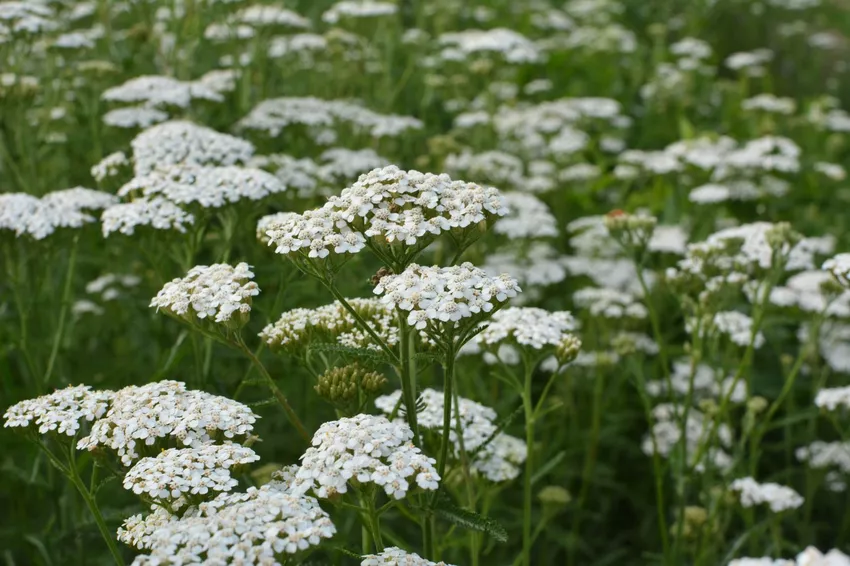The common or common yarrow is a native, easy-care flowering perennial. We present a portrait of the medicinal plant and give tips on planting it in your own garden.

Yarrow has been an integral part of every monastery pharmacy for hundreds of years. We will introduce you to the local medicinal plant and its requirements in terms of location and care.
Yarrow: flower, origin and properties
The common yarrow (Achillea millefolium), also called meadow yarrow, belongs to the daisy family (Asteraceae). It is probably the best-known of all yarrow species and is particularly valued as a medicinal and bee plant. The native weed is widespread in Europe, North America and Asia and is often found at the edges of forests, fields, embankments and species-rich semi-arid meadows. The perennial, hardy perennial reaches a height of up to 80 cm. The fine, aromatic-scented leaves of the yarrow are elongated and split into two or three pinnate parts and arranged alternately on the stem. The common yarrow is also known as the "thousand leaf" because of its filigree foliage. The flowering period of the yarrow is between June and August, which can be extended into October by pruning after the first flowering. Bordered with white, pink, orange, or red ray florets, the umbel-like inflorescences are particularly attractive to hoverflies and other pollinators. Although the flowers contain only comparatively low amounts of nectar and pollen, they bloom for an extremely long time and thus also provide food in mid and late summer. In autumn, the elongated, brown yarrow seeds, the so-called achenes, ripen and eventually fall to the ground. The wild forms of yarrow also spread via underground root runners, while many varieties grow in clumps and are true to the site.

Planting common yarrow: in a bucket or in the garden?
The optimal location for yarrow is sunny to moderateacidic to neutral, well-drained and humus-rich soils. The best time to plant perennials is in autumn between October and the end of November. Alternatively, you can also plant yarrow in early spring from March. At this time of year, you should make sure that you have sufficient watering, as the plants still have few roots and may need to be watered, especially in summer. Many yarrow varieties form clumps and are about 40 to 50 cm wide, which is why a planting distance of at least 45 cm should be maintained. About four to six plants are planted per square meter.
Yarrows can basically be planted both in beds and in pots. A high-quality, nutrient-rich potting soil, such as our Plantura organic universal soil, is suitable for planting in balcony boxes or tubs. Thanks to the high compost content, the pre-fertilized substrate does not contain any peat that is harmful to the climate and is sustainably produced in Germany. Good water drainage and a 5 to 10 cm high drainage layer at the bottom of the planter made of gravel, sand or expanded clay also prevents waterlogging and root rot in the pot. When planting, do not plant the perennials deeper into the ground than they were already in the pot.
The most important care measures
Yarrows are extremely easy to care for and undemanding flowering perennials. Pruning takes place in late autumn when the plant dies above ground, or alternatively in the following spring when new growth takes place. If the dead plants survive the winter, this can even protect against frost and severe sub-zero temperatures in winter. Many varieties are also reblooming - so you should cut your yarrow immediately after flowering so that a second flower forms in October. Yarrows rarely require fertilization, a dose of mature compost or predominantly organic long-term fertilizer in the spring is usually sufficient.
Sufficient winter protection is important when cultivating yarrow in tubs, because although the plant is hardy, the root ball must never freeze completely. An insulation made of coniferous branches, fleece or jute around the pot protects the sensitive roots from sub-zero temperatures.Is common yarrow poisonous?
Common yarrow is not poisonous, neither for humans nor for pets such as cats and dogs.
Rodents such as guinea pigs and rabbits even like to eat yarrow in dried form as hay. Yarrow is also non-toxic for horses, but they usually leave the wild perennial on the pasture despite its positive effectsstand untouched. The tolerability of concentrated extracts and tinctures that are administered to animals can be different. It's best to ask your vet about this.

Common yarrow: uses and medicinal properties
Yarrow blossoms and the leaves contain essential oils, which have an antispasmodic and anti-inflammatory effect. Already Hildegard von Bingen used yarrow to heal wounds and inflammations. Externally, extracts, ointments or pure yarrow oil are used to support wound healing, skin inflammation and menstrual cramps. Yarrow tinctures and teas have an internal effect similar to chamomile (Matricaria) for loss of appetite and abdominal cramps. In sensitive people, however, yarrow can trigger allergic skin reactions and should therefore generally only be taken after consulting a doctor.

Comfrey (Symphytum officinale) is a wild plant native to us that has healing properties. We present the bee-friendly medicinal plant in the profile.